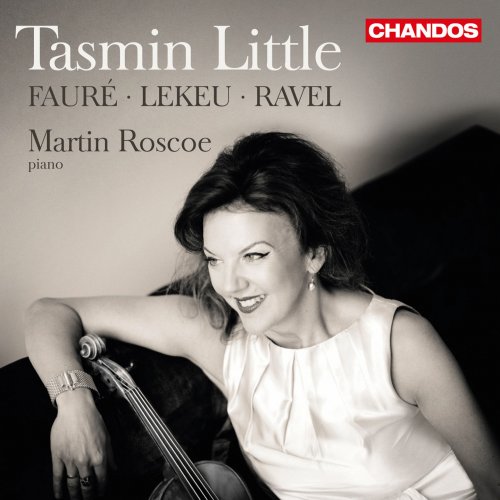
Tasmin Little, Martin Roscoe - Fauré, Lekeu & Ravel: Violin Sonatas (2014) Hi-Res
BAND/ARTIST: Tasmin Little, Martin Roscoe
- Title: Fauré, Lekeu & Ravel: Violin Sonatas
- Year Of Release: 2014
- Label: Chandos
- Genre: Classical
- Quality: FLAC (tracks) 24bit-96kHz
- Total Time: 01:12:55
- Total Size: 1.3 Gb
- WebSite: Album Preview
Tracklist:
Violin Sonata in G major (Guillaume Lekeu)
1. I. Très modéré - Vif et passioné 11:43
2. II. Très lent 10:28
3. III. Très animé 10:19
Violin Sonata, Op. posth. (Maurice Ravel)
4. Violin Sonata No. 1 in A Minor, M. 12 14:23
Violin Sonata No. 1 in A major, Op. 13 (Gabriel Fauré)
5. I. Allegro molto 08:45
6. II. Andante 07:36
7. III. Allegro vivo 04:12
8. IV. Allegro quasi presto 05:29
Performers:
Tasmin Little, violin
Martin Roscoe, piano
Violin Sonata in G major (Guillaume Lekeu)
1. I. Très modéré - Vif et passioné 11:43
2. II. Très lent 10:28
3. III. Très animé 10:19
Violin Sonata, Op. posth. (Maurice Ravel)
4. Violin Sonata No. 1 in A Minor, M. 12 14:23
Violin Sonata No. 1 in A major, Op. 13 (Gabriel Fauré)
5. I. Allegro molto 08:45
6. II. Andante 07:36
7. III. Allegro vivo 04:12
8. IV. Allegro quasi presto 05:29
Performers:
Tasmin Little, violin
Martin Roscoe, piano
Our exclusive Chandos artist Tasmin Little explores three great French violin sonatas, after a much revered recording of British violin sonatas in 2013. She and pianist Martin Roscoe have enjoyed a longstanding chamber music partnership. On this album they immerse themselves in music of three of the best late-nineteenth-century French composers: Gabriel Fauré, Guillaume Lekeu, and Maurice Ravel.
Written in 1875, shortly after his thirtieth birthday, the Sonata in A major by Gabriel Fauré has often been regarded as his first masterpiece. And despite having faced a daunting reception, it has become a reference in the romantic repertoire. The first two movements, serious and solemn, are followed by light-footed, airy movements, the final Allegro drawing energy from Fauré's favourite off-beat chordal accompaniment.
As the last arrival in the 'Bande à Franck', Guillaume Lekeu, in his twenty-fouryear- long life, wrote some fifty pieces of 'tremulous emotion', of which the Violin Sonata, of 1892 93, is by far the best known.
The opening movement of an unfinished early violin sonata by Ravel was not published until 1975, his centenary year, and the first known modern performance took place that year in New York. The movement convincingly unites different styles, from Fauré's in the modal opening to Franckian chords in the development passage that leads back to the tune over chromatically descending triads à la Debussy, not to mention a second theme, over pulsing quavers, that clearly belongs to the Gounod / Massenet tradition.
Written in 1875, shortly after his thirtieth birthday, the Sonata in A major by Gabriel Fauré has often been regarded as his first masterpiece. And despite having faced a daunting reception, it has become a reference in the romantic repertoire. The first two movements, serious and solemn, are followed by light-footed, airy movements, the final Allegro drawing energy from Fauré's favourite off-beat chordal accompaniment.
As the last arrival in the 'Bande à Franck', Guillaume Lekeu, in his twenty-fouryear- long life, wrote some fifty pieces of 'tremulous emotion', of which the Violin Sonata, of 1892 93, is by far the best known.
The opening movement of an unfinished early violin sonata by Ravel was not published until 1975, his centenary year, and the first known modern performance took place that year in New York. The movement convincingly unites different styles, from Fauré's in the modal opening to Franckian chords in the development passage that leads back to the tune over chromatically descending triads à la Debussy, not to mention a second theme, over pulsing quavers, that clearly belongs to the Gounod / Massenet tradition.
DOWNLOAD FROM ISRA.CLOUD
Tasmin Little Martin Roscoe Fauré Lekeu & Ravel Violin Sonatas 14 1612.rar - 1.3 GB
Tasmin Little Martin Roscoe Fauré Lekeu & Ravel Violin Sonatas 14 1612.rar - 1.3 GB
Classical | FLAC / APE | HD & Vinyl
As a ISRA.CLOUD's PREMIUM member you will have the following benefits:
- Unlimited high speed downloads
- Download directly without waiting time
- Unlimited parallel downloads
- Support for download accelerators
- No advertising
- Resume broken downloads


